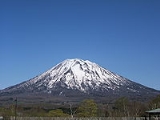
Mount Yotei
Encyclopedia
is an active stratovolcano
located in Shikotsu-Toya National Park
, Hokkaidō
, Japan
. It is also called , because it resembles the more famous Mount Fuji
. The mountain is also known as and . It is one of the 100 famous mountains in Japan.
indicates two eruptions at Mount Yotei. The most recent circa 1050 BC from a cone emerging from the northwest flank of the mountain at . The earlier eruption is dated from circa 3550 BC.
Stratovolcano
A stratovolcano, also known as a composite volcano, is a tall, conical volcano built up by many layers of hardened lava, tephra, pumice, and volcanic ash. Unlike shield volcanoes, stratovolcanoes are characterized by a steep profile and periodic, explosive eruptions...
located in Shikotsu-Toya National Park
Shikotsu-Toya National Park
is a national park in the central part of the island of Hokkaidō, Japan. Named after the volcanic caldera lakes of Lake Shikotsu and Lake Tōya, it has a total area of 993.02 square kilometers...
, Hokkaidō
Hokkaido
, formerly known as Ezo, Yezo, Yeso, or Yesso, is Japan's second largest island; it is also the largest and northernmost of Japan's 47 prefectural-level subdivisions. The Tsugaru Strait separates Hokkaido from Honshu, although the two islands are connected by the underwater railway Seikan Tunnel...
, Japan
Japan
Japan is an island nation in East Asia. Located in the Pacific Ocean, it lies to the east of the Sea of Japan, China, North Korea, South Korea and Russia, stretching from the Sea of Okhotsk in the north to the East China Sea and Taiwan in the south...
. It is also called , because it resembles the more famous Mount Fuji
Mount Fuji
is the highest mountain in Japan at . An active stratovolcano that last erupted in 1707–08, Mount Fuji lies about south-west of Tokyo, and can be seen from there on a clear day. Mount Fuji's exceptionally symmetrical cone is a well-known symbol of Japan and it is frequently depicted in art and...
. The mountain is also known as and . It is one of the 100 famous mountains in Japan.
Geology
Mount Yotei is mostly composed of andesite and dacite. The stratovolcano is symmetrical adding to its resemblance to Mount Fuji.Eruptive history
TephrochronologyTephrochronology
250px|thumb|right|Tephra horizons in south-central [[Iceland]]. The thick and light coloured layer at the height of the [[volcanologists]] hands is [[rhyolitic]] [[tephra]] from [[Hekla]]....
indicates two eruptions at Mount Yotei. The most recent circa 1050 BC from a cone emerging from the northwest flank of the mountain at . The earlier eruption is dated from circa 3550 BC.

